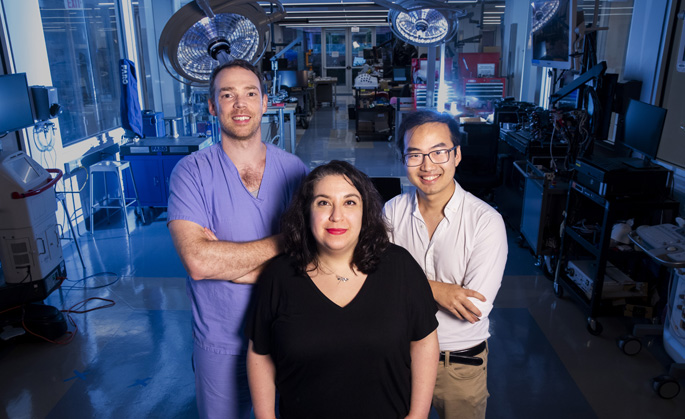
A multidisciplinary team at the Vanderbilt Institute for Surgery and Engineering (VISE) is working to create a real-time navigational system to decrease residual stone fragments left behind after kidney stone surgery.
Of the 100,000 patients who undergo an endoscopic kidney stone removal each year in the United States, 25% will require a repeat stone surgery within 20 months. This is nearly always due to stone fragments left behind, which can lead to ureteral obstruction, urinary tract infection and kidney injury. According to the National Kidney Foundation, it is estimated that 1 in 10 people will have a kidney stone at some time in their lives.
“We hope to transform the surgical care of kidney stone patients,” said co-principal investigator Nicholas Kavoussi, MD, assistant professor of Urology at Vanderbilt University Medical Center. “Endoscopic stone surgery requires the surgeon to visualize the entire renal collecting system to locate every kidney stone, and there are many challenges in this. During surgery, blood or debris can obscure the already limited field of view. Also, successfully navigating through the renal collecting system requires the surgeon to mentally create a 3D model of the patient’s anatomy from preoperative 2D computerized tomography (CT) images.
“During a surgical procedure, kidney stones can fragment and scatter, further complicating intraoperative tracking. We believe that a navigational system during stone surgery can improve stone-free rates, reducing recurrent surgeries and complications from residual fragments.”
By overlaying a 3D model of a patient’s preoperative imaging and updating it during the surgery, the resulting navigational map will allow the surgeon to more accurately track stones and stone fragments. The first-of-its-kind navigational system is expected to identify stone fragments less than 250 micrometers in diameter, a size typically considered to be dust, which can then be removed to alleviate future problems. The navigational system is being designed to work with existing endoscopic surgical cameras, allowing integration with any surgical system in use.
Co-principal investigator Ipek Oguz, PhD, assistant professor at the Vanderbilt University Department of Computer Science, is an expert in machine learning/deep learning methods for medical image segmentation. She and her team will analyze the videos and images obtained during the study to determine the new system’s effectiveness and the impact on patient outcomes.
“At the conclusion of our two-year study we expect to have collected the data needed to justify a large-scale, multicenter trial to evaluate outcomes of kidney stone removal surgeries with and without the navigational system,” Oguz said. “Additionally, our system is generalizable so future researchers developing automated tracking and video segmentation systems could potentially apply our basic approach for other endoscopic surgeries.”
The Department of Urology has an active kidney stone practice, seeing more than 60 patients with kidney stones each week. In the region, VUMC serves as the tertiary referral center for complex kidney stone patients.
“I’ve seen firsthand the impact repeat surgeries have on patients when residual kidney stone fragments cause complications,” Kavoussi said. “They are usually frustrated, often in pain, and the last thing they want is another procedure. Add to that their lost time at work and from their daily activities, and it’s easy to see why this is a surgical challenge we need to resolve.”
VISE is an interdisciplinary, trans-institutional structure designed to facilitate interactions and exchanges between engineers and physicians. Its mission is the creation, development, implementation, clinical evaluation and translation of methods, devices, algorithms and systems designed to facilitate interventional processes and their outcomes.
This research is supported by the National Institute of Diabetes and Digestive and Kidney Diseases (R21DK133742). VISE provided initial support for this project via a physician-in-residence award to Kavoussi and Oguz, which was leveraged to conduct preliminary studies.












